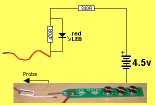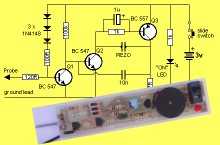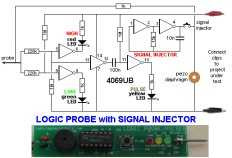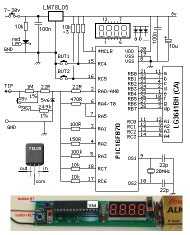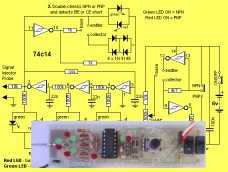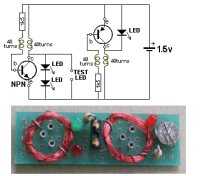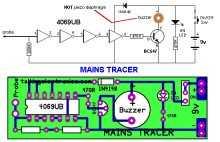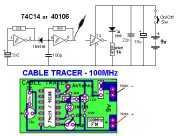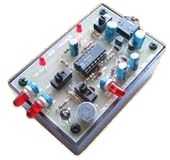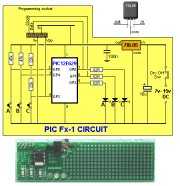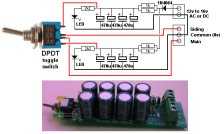Table Of Contents
Kits: [Crossing Sound MkII](mailto:colin@elechelp.com?Subject=Buying Crossing Sound MkII kit&Body=Please%20e-mail%20the%20cost%20of Crossing Sound MkII kit by%20air%20mail%20to%20my%20country:****___****%20%20and%20send%20details%20of%20how%20I%20can%20pay%20for%20it.%20My%20name%20is:____)
US$26.50 plus $6.50 post
2 x Crossing Signals and 2 Boom Gates $8.00
Total: US$41.00 incl postage
This is what you get:
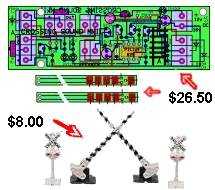
We also have a kit to detect the presence of IR from the IR diodes.
It detects 38kHz IR signals and constant IR signals.
See [IR Detector](//TODO FIXME COLIN) kit: $5.00
We also have a LED TESTER kit and LOGIC PROBE kit to help with testing your projects
This project is designed for a model railway layout.
It provides flashing lights as well as a boom gate bell-sound.
And it is AUTOMATIC.
It is activated by an Infrared Beam and receiver IC that has been placed on a small, narrow PC board fitted between the tracks at a distance from the crossing. Another is fitted at the other side of th crossing about 1 -2 metres from the crossing. The front of the train breaks the beam and activates the circuit. A train in either direction will activate the project.
The circuit waits for a beam to be broken and this produces a HIGH on the input to the microcontroller via an “OR” gate in the circuit. The outputs of the IR detectors are LOW when detecting a beam and when a beam is cut, the output goes HIGH. The diodes in the circuit allow this to take place. In other words th circuit is an “active HIGH” OR-gate.
When the loco passes the other beam it is broken by the front of the train and the sound stops.
The project is then reset and is ready for a train in either direction. All this is done by the microcontroller.
Talking Electronics also has a project to operate a set of boom gates via a slow-acting motor and gearbox to give reality to the activation. The project does not have sound. See BOOM GATES project HERE.
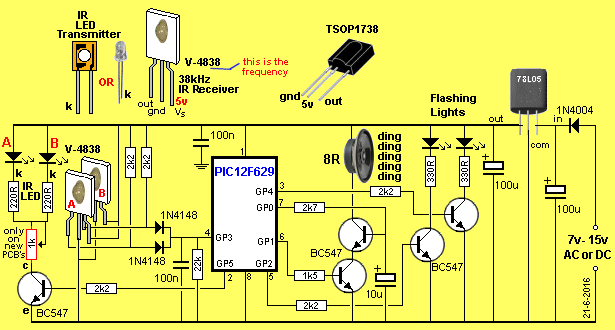
CROSSING SOUND MkII CIRCUIT
TIMING
The project works on TIMING.
The project waits for a beam to be broken and the SOUND AND LIGHTS are activated.
The project produces LIGHT AND SOUND for 5 seconds and then looks to see if the full length of the train has passed the beam. LIGHT AND SOUND continues to be emitted.
The circuit then looks for a second “broken beam” to stop SOUND AND LIGHTS.
This is how the circuit determines the train has passed from one beam to the other.
If you stop the train or delay it or run 2 trains in succession, the timing may not respond correctly.
PRODUCING A TONE
Producing a decaying note with resonance is not an easy task with a microcontroller. We have produced the basics of the tone with a program and used two transistor stages to get the decay.
This results in a ding-ding-ding-ding-ding.
At the same time the two LED flash alternately at a low rate.
We have used IR detectors because the level of light varies from one layout to another and sometimes sunlight enters the room.
This changes the ambient light conditions enormously and fluorescent tubes have an effect on normal light sensing devices.
Adding 38kHz coding to the Infrared transmission eliminates any interference and makes the project very reliable.
IR DETECTOR KIT
A project is available to detect the presence of signal from the IR diodes [IR Detector](//TODO FIXME COLIN).
You can detect the presence by looking at the diodes with a digital camera, but this will not let you know if the LED is pulsing at 38kHz.
The IR DETECTOR kit has two circuits and by moving the detector closer to the IR LED, you can see if the emission is bright enough to be detected by the CROSSING SOUND MkII Project. We don’t want the LED to be too bright as the wrong receiver will pick up the signal. And we don’t want the LED to be too dull or the project will not work. That’s why we have used fairly weak LEDs and put a cover over them to concentrate the beam to only be picked up by the closest receiver.
FLASHING LEDs
The red LEDs in the kit are low bright as super bright LEDs are too bright for the plastic model.
The 4 dummy red lens are removed and the 3mm LEDs fit very neatly.
The shorter cathode leads are at the bottom and one anode lead is bent over to touch the other anode lead.
Both the leads are cut very short and soldered very quickly to prevent them being damaged.
The two cathode leads are also cut very short.
0.2mm enamelled wire is included in the kit and the end is tinned by firstly scraping off the enamel or using the iron to burn off the enamel.
Tin one cathode lead very quickly and solder the wire to it.
Do the same with the other cathode lead.
The third enamel wire is soldered to the middle of the anodes and the three enamel wires are then taken down the back of the pole and taped with sticky-tap to hide them from view.
These three wires can be extended to the project with hook-up wire.
The other crossing light is wired exactly the same and the 3 enamel wires are are joined to the hook-up wire to make a parallel connecting with the first crossing light.
The following two diagrams will help you with the wiring:
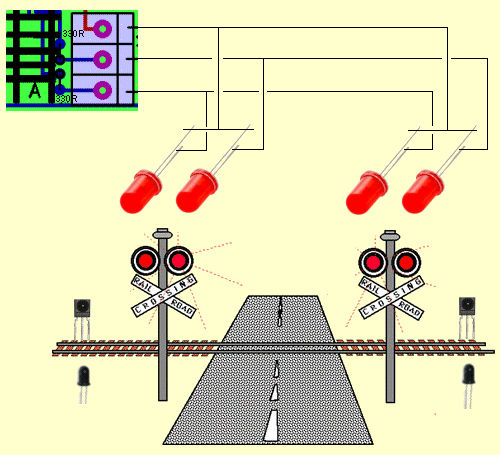

Easy-to-understand circuit
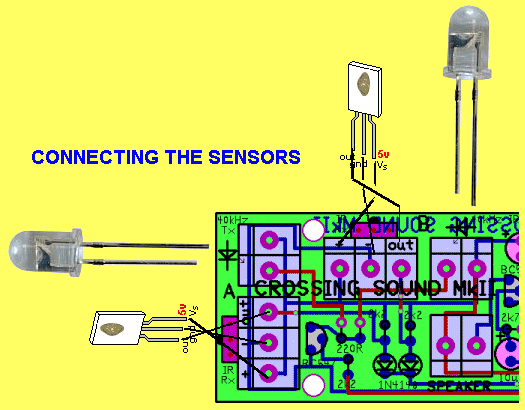
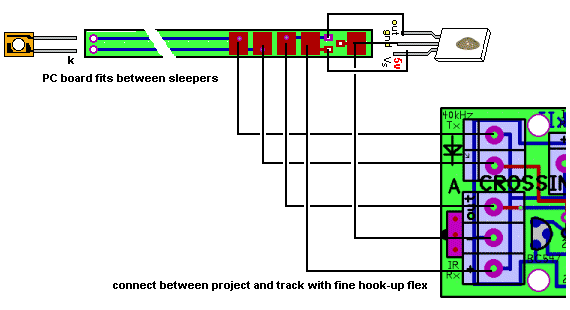
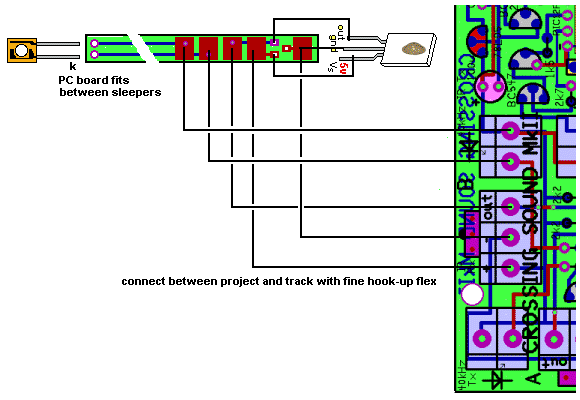
Connecting the sensors to the PC board
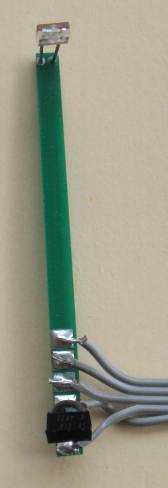
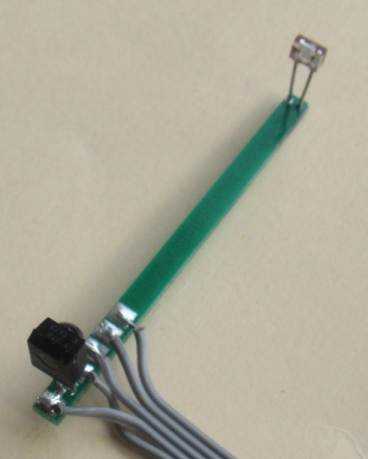
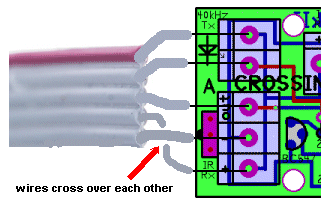
The bottom 2 wires of the flat ribbon cross over.
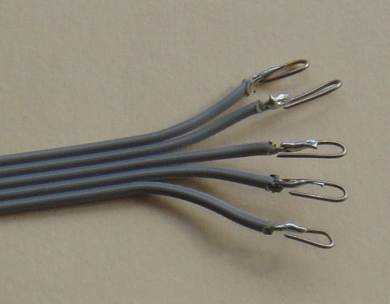
Prepare the ends with tinned copper wire before fitting to terminal blocks
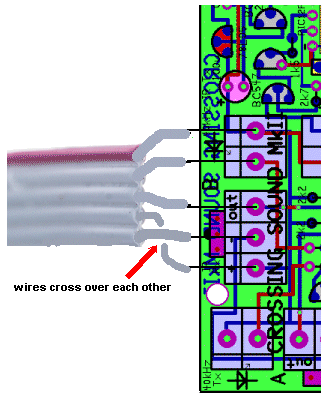
The bottom 2 wires of the flat ribbon cross over.
CONNECTING THE SENSORS:
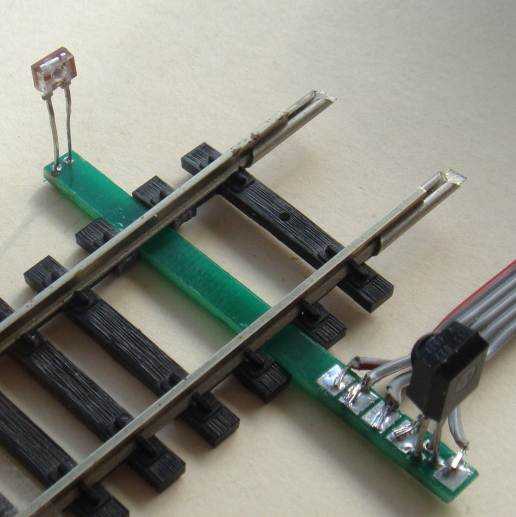
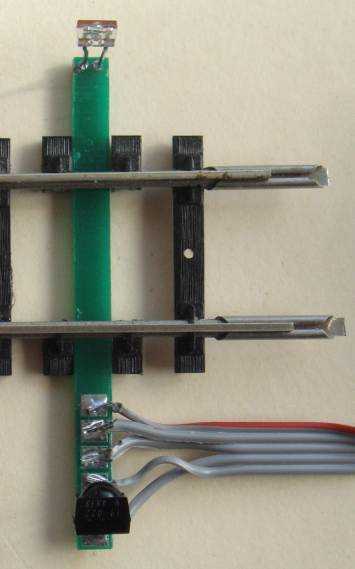
Note: wires 4 and 5 are crossed-over The kit contains black sleeve. Cut 5mm and glue over the LED to prevent the signal spreading.
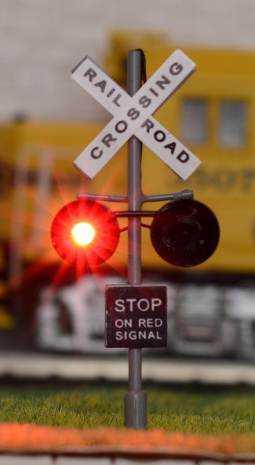
Here is the normal price:
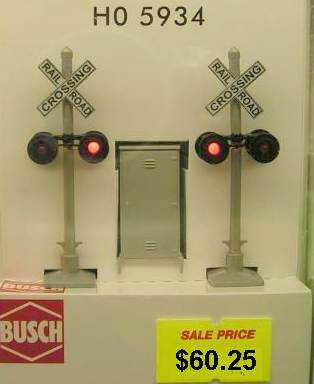
Two Bachmann HO crossing signals are included in the kit
WIRING THE CROSSING SIGNALS LEDs:
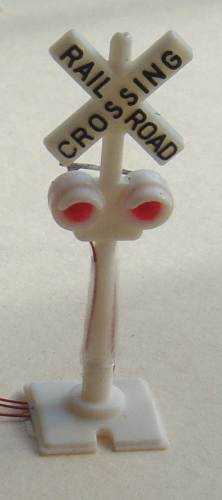
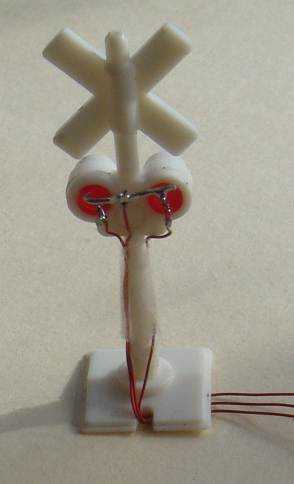
Wiring the 3mm LEDs
BOOM GATES
The kit contains 2 boom gates because the Crossing Signals from Bachmann comes in a pair with 2 Boom Gates.
You will be able to use the Boom Gates at the same crossing as the Signals by using Talking Electronics Boom Gates project.
THE PRINTED CIRCUIT BOARD:
All the components are included in the kit and everything is identified on the board. The terminal blocks make it easy to connect all the leads after the board has been screwed to the layout.
Solder a short length 0.5mm tinned copper wire to the ends of the ribbon cable before fitting into the terminal blocks to hold the wire in place.
It is best to use a DC supply but an AC supply up to 16v can be used as the single power diode will provide half-wave rectification and the regulator will just manage to deliver a smooth 5v at 50mA load.

PARTS LIST
$26.50 plus $6.50 post
Order a kit: [Crossing Sound MkII](mailto:colin@elechelp.com?Subject=Buying Crossing Sound MkII kit&Body=Please%20e-mail%20the%20cost%20of Crossing Sound MkII kit by%20air%20mail%20to%20my%20country:****___****%20%20and%20send%20details%20of%20how%20I%20can%20pay%20for%20it.%20My%20name%20is:____)
2 - 220R
2 - 330R
1 - 1k5
5 - 2k2
1 - 2k7
1 - 22k
1 - 1k mini trim pot (some PCB’s will have a pot to adjust the LED brightness)
1 - 100n monoblock
1 - 10u electrolytic
2 - 100u electrolytics
2 - 1N4148 signal diode
1 - 1N4004 power diode
4 - low bright 3mm red LEDs
2 - IR LEDs (transmitters)
2 - V4838 38kHz receivers
5 - BC547 transistors
1 - 78L05 3-terminal regulator (100mA)
1 - PIC12F629 with “Xing”
1 - 8 pin IC socket
2 - component header pins for test points
2 - Sensor Connector strips (see text)
4 - 2-way terminal block
3 - 3-way terminal block
1 - metre 5-wire flat ribbon
2 - Bachmann Crossing Signals
2 - Bachmann Boom Gates (use in [Boom Gates](//TODO FIXME COLIN) project)
2 - 10cm 0.6mm wire for boom push rod
1 - 1cm black sleeve to cover IR Tx LEDs.
1 - 3metre 0.2mm enamelled wire (for LEDs on Crossing Signals) 20cm 0.5mm tinned copper wire (for ends of ribbon cable into terminal blocks to make the screw grip the wire)
1 - 8R mini speaker
1 - 20cm very fine solder
1 - Crossing Sound MkII PCB
2 - Sensor Connector PCB
TEST EQUIPMENT
Talking Electronics has a number of pieces of TEST EQUIPMENT to help in the design and testing of projects.
Of course you can use a multimeter for most of the testing but some of the “tricky” faults need a special piece of equipment.
You may only need a LOGIC PROBE once a month, but the project you are designing will come to a stand-still if you can’t locate a problem.
We designed all these projects because we needed them ourselves.
Add one of them to each order you place with Talking Electronics and eventually you will have the whole range.
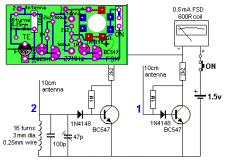
Quick Links
Legal Stuff
Social Media


